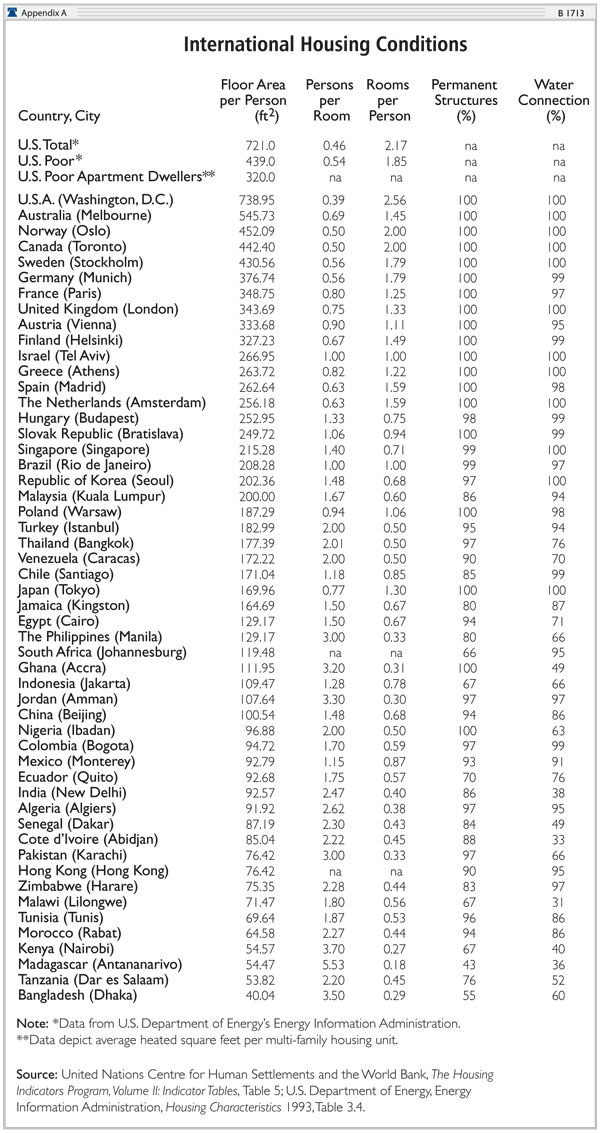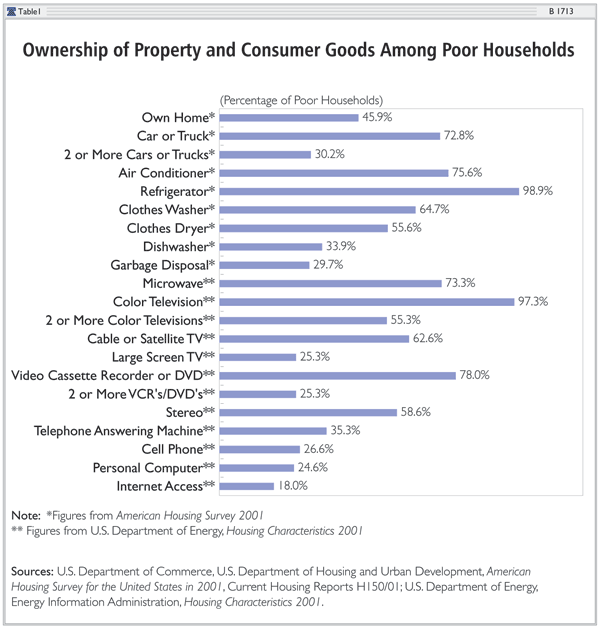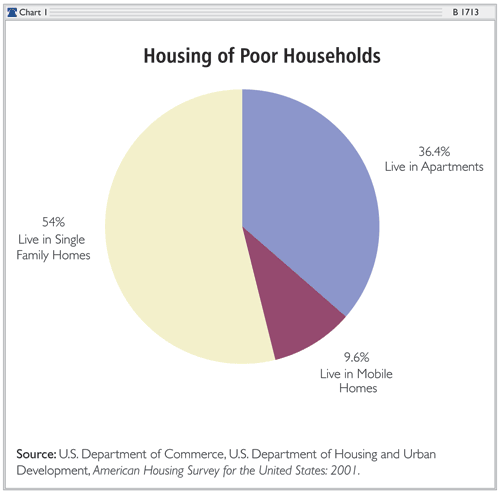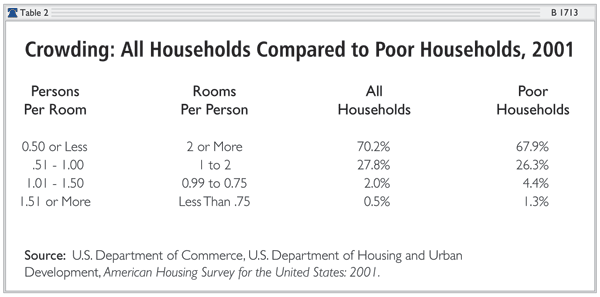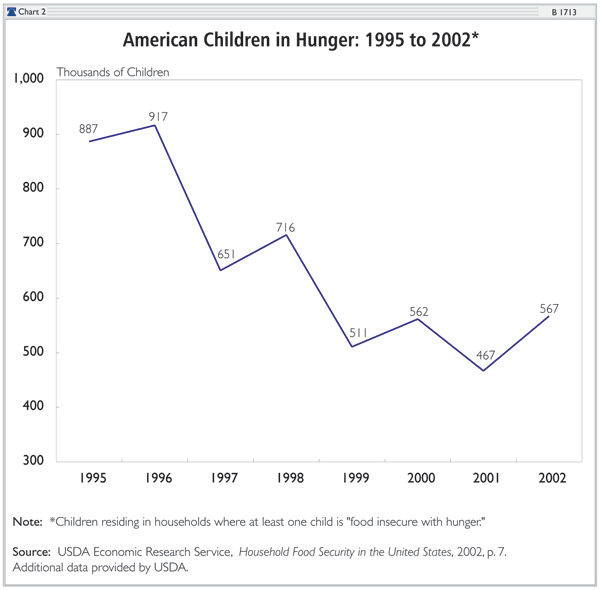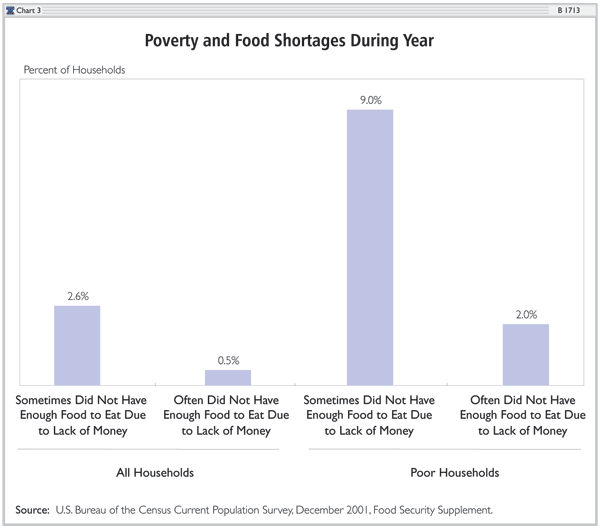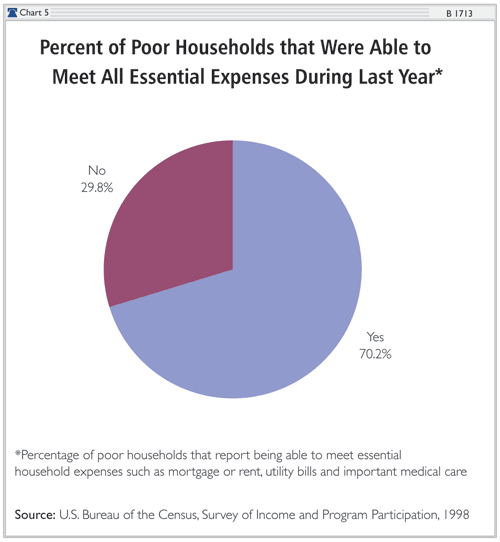|
This key research from 2004 has been updated in Robert Rector's new paper, How Poor Are America's Poor? Examining the "Plague" of Poverty in America Each year, the U.S. Census Bureau counts the number of "poor" persons in the U.S. In 2005, the Bureau found 37 million "poor" Americans. Presidential candidate John Edwards claims that these 37 million Americans currently "struggle with incredible poverty." Edwards asserts that America's poor, who number "one in eight of us…do not have enough money for the food, shelter, and clothing they need," and are forced to live in "terrible" circumstances.However, an examination of the living standards of the 37 million persons, whom the government defines as "poor," reveals that what Edwards calls "the plague" of American poverty might not be as "terrible" or "incredible" as candidate Edwards contends. |
Poverty is an important and emotional issue. Last year, the Census Bureau released its annual report on poverty in the United States declaring that there were nearly 35 million poor persons living in this country in 2002, a small increase from the preceding year. To understand poverty in America, it is important to look behind these numbers to look at the actual living conditions of the individuals the government deems to be poor.
For most Americans, the word "poverty" suggests destitution: an inability to provide a family with nutritious food, clothing, and reasonable shelter. But only a small number of the 35 million persons classified as "poor" by the Census Bureau fit that description. While real material hardship certainly does occur, it is limited in scope and severity. Most of America's "poor" live in material conditions that would be judged as comfortable or welloff just a few generations ago. Today, the expenditures per person of the lowestincome onefifth (or quintile) of households equal those of the median American household in the early 1970s, after adjusting for inflation.1
The following are facts about persons defined as "poor" by the Census Bureau, taken from various government reports:
- Fortysix percent of all poor households actually own their own homes. The average home owned by persons classified as poor by the Census Bureau is a threebedroom house with oneandahalf baths, a garage, and a porch or patio.
- Seventysix percent of poor households have air conditioning. By contrast, 30 years ago, only 36 percent of the entire U.S. population enjoyed air conditioning.
- Only 6 percent of poor households are overcrowded. More than twothirds have more than two rooms per person.
- The average poor American has more living space than the average individual living in Paris, London, Vienna, Athens, and other cities throughout Europe. (These comparisons are to the average citizens in foreign countries, not to those classified as poor.)
- Nearly threequarters of poor households own a car; 30 percent own two or more cars.
- Ninetyseven percent of poor households have a color television; over half own two or more color televisions.
- Seventyeight percent have a VCR or DVD player; 62 percent have cable or satellite TV reception.
- Seventythree percent own microwave ovens, more than half have a stereo, and a third have an automatic dishwasher.
As a group, America's poor are far from being chronically undernourished. The average consumption of protein, vitamins, and minerals is virtually the same for poor and middleclass children and, in most cases, is well above recommended norms. Poor children actually consume more meat than do higherincome children and have average protein intakes 100 percent above recommended levels. Most poor children today are, in fact, supernourished and grow up to be, on average, one inch taller and 10 pounds heavier that the GIs who stormed the beaches of Normandy in World War II.
While the poor are generally wellnourished, some poor families do experience hunger, meaning a temporary discomfort due to food shortages. According to the U.S. Department of Agriculture (USDA), 13 percent of poor families and 2.6 percent of poor children experience hunger at some point during the year. In most cases, their hunger is shortterm. Eightynine percent of the poor report their families have "enough" food to eat, while only 2 percent say they "often" do not have enough to eat.
Overall, the typical American defined as poor by the government has a car, air conditioning, a refrigerator, a stove, a clothes washer and dryer, and a microwave. He has two color televisions, cable or satellite TV reception, a VCR or DVD player, and a stereo. He is able to obtain medical care. His home is in good repair and is not overcrowded. By his own report, his family is not hungry and he had sufficient funds in the past year to meet his family's essential needs. While this individual's life is not opulent, it is equally far from the popular images of dire poverty conveyed by the press, liberal activists, and politicians.
Of course, the living conditions of the average poor American should not be taken as representing all the poor. There is actually a wide range in living conditions among the poor. For example, over a quarter of poor households have cell phones and telephone answering machines, but, at the other extreme, approximately onetenth have no phone at all. While the majority of poor households do not experience significant material problems, roughly a third do experience at least one problem such as overcrowding, temporary hunger, or difficulty getting medical care.
The best news is that remaining poverty can readily be reduced further, particularly among children. There are two main reasons that American children are poor: Their parents don't work much, and fathers are absent from the home.
In good economic times or bad, the typical poor family with children is supported by only 800 hours of work during a year: That amounts to 16 hours of work per week. If work in each family were raised to 2,000 hours per year the equivalent of one adult working 40 hours per week throughout the year nearly 75 percent of poor children would be lifted out of official poverty.
Father absence is another major cause of child poverty. Nearly twothirds of poor children reside in singleparent homes; each year, an additional 1.3 million children are born out of wedlock. If poor mothers married the fathers of their children, almost threequarters would immediately be lifted out of poverty.
While work and marriage are steady ladders out of poverty, the welfare system perversely remains hostile to both. Major programs such as food stamps, public housing, and Medicaid continue to reward idleness and penalize marriage. If welfare could be turned around to encourage work and marriage, remaining poverty would drop quickly.
What Is Poverty?
For most Americans, the word "poverty" suggests destitution: an inability to provide a family with nutritious food, clothing, and reasonable shelter. For example, the "Poverty Pulse" poll taken by the Catholic Campaign for Human Development in 2002 asked the general public the question: "How would you describe being poor in the U.S.?" The overwhelming majority of responses focused on homelessness, hunger or not being able to eat properly, and not being able to meet basic needs. 2
But if poverty means lacking nutritious food, adequate warm housing, and clothing for a family, relatively few of the 35 million people identified as being "in poverty" by the Census Bureau could be characterized as poor.3 While material hardship does exist in the United States, it is quite restricted in scope and severity. The average "poor" person, as defined by the government, has a living standard far higher than the public imagines.
Ownership of Property and Amenities Among the Poor
Table 1 shows the ownership of property and consumer durables among poor households. The data are taken from the American Housing Survey for 2001, conducted by the U.S. Department of Housing and Urban Development and the Census Bureau, and the Residential Energy Consumption Survey conducted by the U.S. Department of Energy.4
As the table shows, some 46 percent of poor households own their own home. The typical home owned by the poor is a threebedroom house with oneandahalf baths. It has a garage or carport and a porch or patio and is located on a halfacre lot. The house was constructed in 1967 and is in good repair. The median value of homes owned by poor households was $86,600 in 2001 or 70 percent of the median value of all homes owned in the United States.5
Some 73 percent of poor households own a car or truck; nearly a third own two or more cars or trucks. Over threequarters have air conditioning; by contrast, 30 years ago, only 36 percent of the general U.S. population had air conditioning. Nearly threequarters of poor households own microwaves; a third have automatic dishwashers.
Poor households are wellequipped with modern entertainment technology. It should come as no surprise that nearly all (97 percent) poor households have color TVs, but more than half actually own two or more color televisions. Onequarter own largescreen televisions, 78 percent have a VCR or DVD player, and almost twothirds have cable or satellite TV reception. Some 58 percent own a stereo. More than a third have telephone answering machines, while a quarter have personal computers. While these numbers do not suggest lives of luxury, they are notably different from conventional images of poverty.
Housing Conditions
A similar disparity between popular conceptions and reality applies to the housing conditions of the poor. Most poor Americans live in houses or apartments that are relatively spacious and in good repair. As Chart 1 shows, 54 percent of poor households live in singlefamily homes, either unattached single dwellings or attached units such as townhouses. Another 36.4 percent live in apartments, and 9.6 percent live in mobile homes.6
Housing Space
Both the overall U.S. population and the poor in America live, in general, in very spacious housing. As Table 2 shows, 70 percent of all U.S. households have two or more rooms per tenant. Among the poor, this figure is 68 percent.
Crowding is quite rare; only 2.5 percent of all households and 5.7 percent of poor households are crowded with more than one person per room.7 By contrast, social reformer Jacob Riis, writing on tenement living conditions around 1890 in New York City, described crowded families living with four or five persons per room and some 20 square feet of living space per person.8
Housing space can also be measured by the number of square feet per person. The Residential Energy Consumption survey conducted by the U.S. Department of Energy shows that Americans have an average of 721 square feet of living space per person. Poor Americans have 439 square feet.9 Reasonably comparable international squarefootage data are provided by the Housing Indicator Program of the United Nations Centre for Human Settlements, which surveyed housing conditions in major cities in 54 different nations. This survey showed the United States to have by far the most spacious housing units, with 50 percent to 100 percent more square footage per capita than city dwellers in other industrialized nations.10
America's poor compare favorably with the general population of other nations in square footage of living space. The average poor American has more square footage of living space than does the average person living in London, Paris, Vienna, and Munich. Poor Americans have nearly three times the living space of average urban citizens in middleincome countries such as Mexico and Turkey. Poor American households have seven times more housing space per person than the general urban population of verylowincome countries such as India and China. (See Appendix Table A for more detailed information.)
Some critics have argued that the comparisons in Table 3 are misleading.11 These critics claim that U.S. housing in general cannot be compared to housing in specific European cities such as Paris or London because housing in these cities is unusually small and does not represent the European housing stock overall. To assess the validity of this argument, Table 4 presents national housing data for 15 West European countries. These data represent the entire national housing stock in each of the 15 countries. In general, the national data on housing size are similar to the data on specific European cities presented in Table 3 and Appendix Table A.


As Table 4 shows, U.S. housing (with an average size of 1,875 square feet per unit) is nearly twice as large as European housing (with an average size of 976 square feet per unit.) After adjusting for the number of persons in each dwelling unit, Americans have an average of 721 square feet per person, compared to 396 square feet for the average European.
The housing of poor Americans (with an average of 1,228 square feet per unit) is smaller than that of the average American but larger than that of the average European (who has 976 square feet per unit). Overall, poor Americans have an average of 439 square feet of living space per person, which is as much as or more than the average citizen in most West European countries. (This comparison is to the average European, not poor Europeans.)
Housing Quality
Of course, it might be possible that the housing of poor American households could be spacious but still dilapidated or unsafe. However, data from the American Housing Survey indicate that such is not the case. For example, the survey provides a tally of households with "severe physical problems." Only a tiny portion of poor households and an even smaller portion of total households fall into that category.
The most common "severe problem," according to the American Housing Survey, is a shared bathroom, which occurs when occupants lack a bathroom and must share bathroom facilities with individuals in a neighboring unit. This condition affects about 1 percent of all U.S. households and 2 percent of all poor households. About onehalf of 1 percent (0.5 percent) of all households and 2 percent of poor households have other "severe physical problems." The most common are repeated heating breakdowns and upkeep problems.
The American Housing Survey also provides a count of households affected by "moderate physical problems." A wider range of households falls into this category 9 percent of the poor and nearly 5 percent of total households. However, the problems affecting these units are clearly modest. While living in such units might be disagreeable by modern middleclass standards, they are a far cry from Dickensian squalor. The most common problems are upkeep, lack of a full kitchen, and use of unvented oil, kerosene or gas heaters as the primary heat source. (The last condition occurs almost exclusively in the South.)
Hunger and Malnutrition in America
There are frequent charges of widespread hunger and malnutrition in the United States.12 To understand these assertions, it is important, first of all, to distinguish between hunger and the more severe problem of malnutrition. Malnutrition (also called undernutrition) is a condition of reduced health due to a chronic shortage of calories and nutriments. There is little or no evidence of povertyinduced malnutrition in the United States.
Hunger is a far less severe condition: a temporary but real discomfort caused by an empty stomach. The government defines hunger as "the uneasy or painful sensation caused by lack of food."13 While hunger due to a lack of financial resources does occur in the United States, it is limited in scope and duration. According to the USDA, on a typical day, fewer than one American in 200 will experience hunger due to a lack of money to buy food.14 The hunger rate rises somewhat when examined over a longer time period; according to the USDA, some 6.9 million Americans, or 2.4 percent of the population, were hungry at least once during 2002.15 Nearly all hunger in the United States is shortterm and episodic rather than continuous.16
Some 92 percent of those who experienced hunger in 2002 were adults, and only 8 percent were children. Overall, some 567,000 children, or 0.8 percent of all children, were hungry at some point in 2002. In a typical month, roughly one child in 400 skipped one or more meals because the family lacked funds to buy food.
Not only is hunger relatively rare among U.S. children, but it has declined sharply since the mid1990s. As Chart 2 shows, the number of hungry children was cut by a third between 1995 and 2002. According to the USDA, in 1995, there were 887,000 hungry children: by 2002, the number had fallen to 567,000.17
Overall, some 97 percent of the U.S. population lived in families that reported they had "enough food to eat" during the entire year, although not always the kinds of foods they would have preferred. Around 2.5 percent stated their families "sometimes" did not have "enough to eat" due to money shortages, and onehalf of 1 percent (0.5 percent) said they "often" did not have enough to eat due to a lack of funds. (See Chart 3.)
Hunger and Poverty
Among the poor, the hunger rate was obviously higher: During 2002, 12.8 percent of the poor lived in households in which at least one member experienced hunger at some point.18 Among poor children, 2.4 percent experienced hunger at some point in the year.19 Overall, most poor households were not hungry and did not experience food shortages during the year.
When asked, some 89 percent of poor households reported they had "enough food to eat" during the entire year, although not always the kinds of food they would prefer. Around 9 percent stated they "sometimes" did not have enough to eat because of a lack of money to buy food. Another 2 percent of the poor stated that they "often" did not have enough to eat due to a lack of funds.20 (See Chart 3.)
Poverty and Malnutrition
It is widely believed that a lack of financial resources forces poor people to eat lowquality diets that are deficient in nutriments and high in fat. However, survey data show that nutriment density (amount of vitamins, minerals, and protein per kilocalorie of food) does not vary by income class.21 Nor do the poor consume higherfat diets than do the middle class; the percentage of persons with high fat intake (as a share of total calories) is virtually the same for lowincome and uppermiddleincome persons.22 Overconsumption of calories in general, however, is a major problem among the poor, as it is within the general U.S. population.
Examination of the average nutriment consumption of Americans reveals that age and gender play a far greater role than income class in determining nutritional intake. For example, the nutriment intakes of adult women in the upper middle class (with incomes above 350 percent of the poverty level) more closely resemble the intakes of poor women than they do those of uppermiddleclass men, children, or teens.23 The average nutriment consumption of uppermiddleincome preschoolers, as a group, is virtually identical with that of poor preschoolers but not with the consumption of adults or older children in the upper middle class.
This same pattern holds for adult males, teens, and most other age and gender groups. In general, children aged 011 years have the highest average level of nutriment intakes relative to the recommended daily allowance (RDA), followed by adult and teen males. Adult and teen females have the lowest level of intakes. This pattern holds for all income classes.
Nutrition and Poor Children
Government surveys provide little evidence of widespread undernutrition among poor children; in fact, they show that the average nutriment consumption among the poor closely resembles that of the upper middle class. For example, children in families with incomes below the poverty level actually consume more meat than do children in families with incomes at 350 percent of the poverty level or higher (roughly $65,000 for a family of four in today's dollars).
Table 5 shows the average intake of protein, vitamins, and minerals as a percentage of the recommended daily allowance among poor and middleclass children at various age levels.24 The intake of nutriments is very similar for poor and middleclass children and is generally well above the recommended daily level. For example, the consumption of protein (a relatively expensive nutriment) among poor children is, on average, between 150 percent and 267 percent of the RDA.
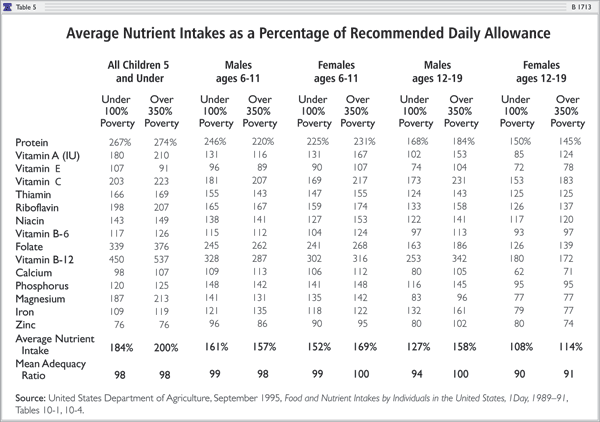
When shortfalls of specific vitamins and minerals appear (for example, among teenage girls), they tend to be very similar for the poor and the middle class. While poor teenage girls, on average, tend to underconsume vitamin E, vitamin B6, calcium, phosphorus, magnesium, iron, and zinc, a virtually identical underconsumption of these same nutriments appears among upper middleclass girls.
Poor Children's Weight and Stature
On average, poor children are very wellnourished, and there is no evidence of widespread significant undernutrition. For example, two indicators of undernutrition among the young are "thinness" (low weight for height) and stuntedness (low height for age). These problems are rare to nonexistent among poor American children.
The generally good health of poor American children can be illustrated by international comparisons. Table 6 provides data on children's size based on the World Health Organization (WHO) Global Data Base on Child Growth: Children are judged to be short or "stunted" if their height falls below the 2.3 percentile level of standard heighttoage tables.25 Table 6 shows the percentage of children under age five in developing nations who are judged to be "stunted" by this standard.
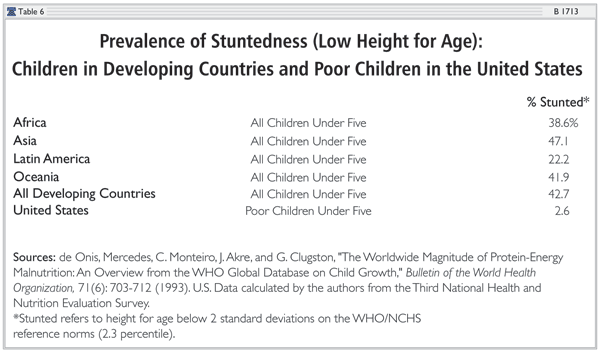
In developing nations as a whole, some 43 percent of children are stunted. In Africa, more than a third of young children are affected; in Asia, nearly half.26 By contrast, in the United States, some 2.6 percent of young children in poor households are stunted by a comparable standard a rate only slightly above the expected standard for healthy, wellnourished children.27 While concern for the wellbeing of poor American children is always prudent, the data overall underscore how large and wellnourished poor American children are by global standards.
Throughout this century, improvements in nutrition and health have led to increases in the rate of growth and ultimate height and weight of American children. Poor children have clearly benefited from this trend. Poor boys today at ages 18 and 19 are actually taller and heavier than boys of similar age in the general U.S. population in the late 1950s. Poor boys living today are one inch taller and some 10 pounds heavier than GIs of similar age during World War II, and nearly two inches taller and 20 pounds heavier than American doughboys back in World War I.28
Poverty and Obesity
The principal nutritionrelated health problem among the poor, as with the general U.S. population, stems from the overconsumption, not underconsumption, of food. While overweight and obesity are prevalent problems throughout the U.S. population, they are found most frequently among poor adults. Poor adult men are slightly less likely than nonpoor men to be overweight (30.4 percent compared to 31.9 percent); but, as Chart 4 shows, poor adult women are significantly more likely to be overweight than are nonpoor women (47.3 percent compared to 32 percent).29
Living Conditions and Hardships Among the Poor
Overall, the living standards of most poor Americans are far higher than is generally appreciated. The overwhelming majority of poor families are wellhoused, have adequate food, and enjoy a wide range of modern amenities, including air conditioning and cable television. Some 70 percent of poor households report that during the course of the past year they were able to meet "all essential expenses," including mortgage, rent, utility bills, and important medical care.30 (See Chart 5.)
However, two caveats should be applied to this generally optimistic picture. First, many poor families have difficulty paying their regular bills and must scramble to make ends meet. For example, around onequarter of poor families are late in paying the rent or utility bills at some point during the year.
Second, the living conditions of the average poor household should not be taken to represent all poor households. There is a wide range of living conditions among the poor; while more than a quarter of the poor have cell phones and answering machines, a tenth of the poor have no telephone at all. While most of America's poor live in accommodations with two or more rooms per person, roughly a tenth of the poor are crowded, with less than one room per person.
These points are illustrated in Table 7, which lists the financial and material hardships among poor households in 1998.31 During at least one month in the preceding year, some 20 percent of poor households reported they were unable to pay their fuel, gas, or electric bills promptly; around 4 percent had their utilities cut off at some point due to nonpayment. Another 13 percent of poor households failed, at some point in the year, to make their full monthly rent or mortgage payments, and 1 percent were evicted due to failure to pay rent. One in 10 poor families had their phones disconnected due to nonpayment at some time during the preceding year.

Overall, more than onequarter of poor families experienced at least one financial difficulty during the year. Most had a late payment of rent or utility bills. Some 12 percent had phones or utilities cut off or were evicted.
Poor households also experienced the material problems listed on Table 7.32 Some 14 percent lacked medical insurance and had a family member who needed to go to a doctor or hospital but did not go; 11 percent experienced hunger in the household; and around 9 percent were overcrowded, with more than one person per room. Slightly less than 4 percent of poor households experienced upkeep problems with the physical conditions of their apartments or homes, having three or more of the physical problems listed in Table 7.
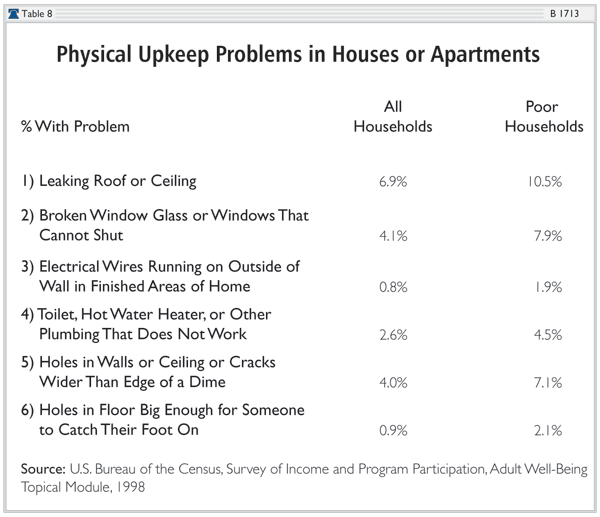
Overall Hardship
Altogether, around 58 percent of poor households experienced none of the financial or physical hardships listed in Table 7 These families were able to pay all their bills on time. They were able to obtain medical care if needed, were not hungry or crowded, and had few upkeep problems in the home. Another 20 percent of poor households experienced one financial or material problem during the year. Around 10 percent of poor households had two financial or material problems, while 12 percent had three or more.
The most common problem facing poor households was late payment of rent or utilities. While having difficulty paying monthly bills is stressful, in most cases late payment did not result in material hardship or deprivation. If late payment problems are excluded from the count, we find that twothirds of poor households had none of the remaining problems listed in Table 7. Some 22 percent had one problem, and 12 percent had two or more problems.
While it is appropriate to be concerned about the difficulties faced by some poor families, it is important to keep these problems in perspective. Many poor families have intermittent difficulty paying rent or utility bills but remain very wellhoused by historic or international standards. Even poor families who are overcrowded and hungry, by U.S. standards, are still likely to have living conditions that are far above the world average.
Reducing Child Poverty
The generally high living standards of poor Americans are good news. Even better is the fact that our nation can readily reduce remaining poverty, especially among children. To accomplish this, we must focus on the main causes of child poverty: low levels of parental work and high levels of single parenthood.
In good economic times or bad, the typical poor family with children is supported by only 800 hours of work during a year: That amounts to 16 hours of work per week. If work in each family were raised to 2,000 hours per year the equivalent of one adult working 40 hours per week through the year nearly 75 percent of poor children would be lifted out of official poverty.33
The decline in marriage is the second major cause of child poverty. Nearly twothirds of poor children reside in singleparent homes; each year, an additional 1.3 million children are born out of wedlock. Increasing marriage would substantially reduce child poverty: If poor mothers married the fathers of their children, almost threequarters would immediately be lifted out of poverty.34
In recent years, the United States has established a reasonable record in reducing child poverty. Successful antipoverty policies were partially implemented in the welfare reform legislation of 1996, which replaced the old Aid to Families with Dependent Children (AFDC) program with a new program called Temporary Assistance to Needy Families (TANF).
A key element of this reform was a requirement that some welfare mothers either prepare for work or get jobs as a condition of receiving aid. As this requirement went into effect, welfare rolls plummeted and employment of single mothers increased in an unprecedented manner. As employment of single mothers rose, child poverty dropped rapidly. For example, in the quartercentury before welfare reform, there was no net change in the poverty rate of children in singlemother families; after reform was enacted, the poverty rate dropped in an unprecedented fashion, falling from 53.1 percent in 1995 to 39.8 percent in 2001.35
In general, however, welfare reform has been limited in both scope and intensity. Even in the TANF program, over half the adult beneficiaries are idle on the rolls and are not engaged in activities leading to selfsufficiency. Work requirements are virtually nonexistent in related programs such as food stamps and public housing. Even worse, despite the fact that marriage has enormous financial and psychological benefits for parents and children, welfare reform has done little or nothing to strengthen marriage in lowincome communities. Overall, the welfare system continues to encourage idle dependence rather than work and to reward single parenthood while penalizing marriage.
If child poverty is to be substantially reduced, welfare must be transformed. Ablebodied parents must be required to work or prepare for work, and the welfare system should encourage rather than penalize marriage.
Conclusion
The living conditions of persons defined as poor by the government bear little resemblance to notions of "poverty" held by the general public. If poverty is defined as lacking adequate nutritious food for one's family, a reasonably warm and dry apartment to live in, or a car with which to get to work when one is needed, then there are relatively few poor persons remaining in the United States. Real material hardship does occur, but it is limited in scope and severity.
The typical American defined as "poor" by the government has a car, air conditioning, a refrigerator, a stove, a clothes washer and dryer, and a microwave. He has two color televisions, cable or satellite TV reception, a VCR or DVD player, and a stereo. He is able to obtain medical care. His home is in good repair and is not overcrowded. By his own report, his family is not hungry and he had sufficient funds in the past year to meet his family's essential needs. While this individual's life is not opulent, it is equally far from the popular images of dire poverty conveyed by the press, liberal activists, and politicians.
But the living conditions of the average poor person should not be taken to mean that all poor Americans live without hardship. There is a wide range of living conditions among the poor. Roughly a third of poor households do face material hardships such as overcrowding, intermittent food shortages, or difficulty obtaining medical care. However, even these households would be judged to have high living standards in comparison to most other people in the world.
Perhaps the best news is that the United States can readily reduce its remaining poverty, especially among children. The main causes of child poverty in the United States are low levels of parental work and high numbers of singleparent families. By increasing work and marriage, our nation can virtually eliminate remaining child poverty.
Robert E. Rector is Senior Research Fellow in Domestic Policy Studies and Kirk A. Johnson, Ph.D., is Harry and Jeanette Weinberg Fellow in Statistical Welfare Research in the Center for Data Analysis at The Heritage Foundation.
